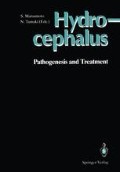Summary
Optimal management in childhood hydrocephalus requires prevention of secondary ischemic damage and reliable indication for surgical treatment to prevent long-term shunt related complications. Transcranial Doppler ultrasound provides a noninvasive means of monitoring cerebrohemodynamic response. Cerebral blood flow velocity (CBFV) and intracranial pressure (ICP) was measured during 38 CSF taps in 11 patients (6 neonates, 5 children). The Resistance Index (RI = S — D/S) (where S — peak systolic velocity and D — end diastolic velocity) decreased significantly (P < .001) after all taps, mainly due to a larger percentage increase in diastolic velocity and mean flow velocity (MFV) which increased in 89% of taps, suggesting a significant reduction in cerebrovascular resistance and increased flow after cerebrospinal fluid (CSF) depletion. There was a significant positive correlation of RI to ICP (r = 0.63, P < .001) in older children. Exponential decay of RI with volume depletion allows estimation of “critical” volume buffering capacity. Serial volume flow velocity response (VFR) in individual infants may indicate progression or arrest of the hydrocephalic process and may help to select more precisely those who will benefit from surgical intervention.
Access this chapter
Tax calculation will be finalised at checkout
Purchases are for personal use only
Preview
Unable to display preview. Download preview PDF.
References
Aaslid R, Markwalder TM, Nornes H (1982) Noninvasive transcranial Doppier ultrasound recording of flow velocity in basal cerebral arteries. J Neurosurg57: 769–774
Archer LNJ, Evans DH, Paton JY, Levene MI (1986) Controlled hypercapnia and neonatal cerebral artery Doppler ultrasound waveforms. Pediatrics 20: 218–221
Bada HS, Hajjar W, Chua C, et al. (1979) Noninvasive diagnosis of neonatal asphyxia and intraventricular hamorrhage by Doppler ultrasound. J Pediatr95: 775
Bode H (1989) Transcranial Doppler sonography in children. J Child Neurol 4: S68–S76
Chadduck WM, Seibert JJ (1989) Intracranial duplex Doppler: Practical uses in pediatric neurology and neurosurgery. J Child Neurol 4: S77–S86
Hill A, Volpe JJ (1982) Decrease in pulsatile flow in the anterior cerebral arteries in infantile hydrocephalus. Pediatrics 69: 4–7
Leggate JRS, Baxter P, Minns RA, et al. (1988) Role of a separate subcutaneous cerebrospinal fluid reservoir in the management of hydrocephalus. Br J Neurosurg 2: 327–338
Miller JD, Garibi J, Pickard JD (1973) Induced changes of cerebrospinal fluid volume: Effects during continous monitoring of ventricular fluid pressure. Arch Neurol 28: 265
Minns RA, Engleman HM, Stirling H (1989) Cerebrospinal fluid pressure in pyogenic meningitis. Arch Dis Child 64: 814–820
Pourcelot L (1976) Diagnostic ultrasound for cerebral vascular diseases. In: Donald I, Levi S (eds) Present and future of diagnostic ultrasound. Kookyer, Rotterdam, pp 141–147
Seibert JJ, McCowan TC, Chadduck WM (1989) Duplex pulsed Doppler US versus intracranial pressure in the neonate: clinical and experimental studies. Radiology 171: 155–159
Shapiro K, Fried A, Marmarou A (1985) Biomechanical and hydrodynamic character ization of the hydrocephalic infant. J Neurosurg 63: 69–75
Shulman K, Marmarou A (1971) Pressure volume considerations in infantile hydrocephalus. Dev Med Child Neurol 13: 90
Van Bel F, Van de Bor M, Baan J, et al. (1988) Blood flow velocity patterns of the anterior cerebral arteries before and after drainage of posthamorraghic hydrocephalus in the newborn. J Ultrasound Med 7: 553–559
Wozniak M, Melone DG, Raimondi AJ (1975) Micro-and macrovascular changes as the direct cause of parenchymal destruction in congenital murine hydrocephalus. J Neurosurg 43: 535–545
Author information
Authors and Affiliations
Editor information
Editors and Affiliations
Rights and permissions
Copyright information
© 1991 Springer-Verlag Tokyo
About this paper
Cite this paper
Minns, R.A., Goh, DE., Pye, S.D., Steers, A.J.W. (1991). A Volume-Blood Flow Velocity Response (VFR) Relationship Derived from CSF Compartment Challenge as an Index of Progression of Infantile Hydrocephalus. In: Matsumoto, S., Tamaki, N. (eds) Hydrocephalus. Springer, Tokyo. https://doi.org/10.1007/978-4-431-68156-4_26
Download citation
DOI: https://doi.org/10.1007/978-4-431-68156-4_26
Publisher Name: Springer, Tokyo
Print ISBN: 978-4-431-68158-8
Online ISBN: 978-4-431-68156-4
eBook Packages: Springer Book Archive

